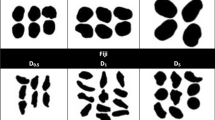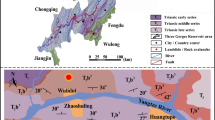Abstract
The effect of the shape of snakeskin-inspired patterns on the shear behaviour of soil-continuum interfaces was investigated for their potential applications in geotechnical engineering. For this purpose, continuum surfaces with ribs inspired from the ventral scales of three different snakes, each with three intra-rib spacings, were fabricated using a 3D printer and their shear behaviour with sand and clay soils was tested under three normal stresses. The results of the interface direct shear tests show that snakeskin-inspired ribs mobilise higher interface shear resistance than an unpatterned surface in sand and clay and considerable inhomogeneous deformations at the interface. The type of soil, the applied normal stress, the shape of the ribs and the direction of shearing were found to be factors that influence and dictate the shear behaviour of the different ribbed interfaces. The snakeskin-inspired ribs mobilised considerable frictional anisotropy owing to the difference in their shapes in the shearing directions. The failure envelopes of the ribbed interfaces were found to follow a nonlinear trend and were described using a power curve. The efficiency of the sand-ribbed interfaces decreased with an increase in normal stress, while a reverse phenomenon was observed in clays, indicating that the interaction mechanism of the ribs is different in different soils for the direct shear test conditions. Digital Image Correlation technique on the sand interfaces revealed that a shear zone of thickness 11 times D50 of sand was mobilised at the interface, further confirming the inhomogeneous deformation at the interfaces.




















Similar content being viewed by others
Data availability
The datasets generated during and analysed during the current study are available from the corresponding author upon reasonable request.
References
Abu-farsakh M, Coronel J, Tao M (2007) Effect of soil moisture content and dry density on cohesive soil–geosynthetic interactions using large direct shear tests. 19:540–549. https://doi.org/10.1061/(ASCE)0899-1561(2007)19
Airey DW, Kelly RB (2010) Interface behaviours from large diameter ring shear tests. In: Frost JD (ed) Proceedings of the research symposium on characterization and behavior of interfaces. IOS Press, Amsterdam, Netherlands, pp 1–6
Alawneh AS, Husein Malkawi AI, Al-Deeky H (1999) Tension tests on smooth and rough model piles in dry sand. Can Geotech J 36:746–753. https://doi.org/10.1139/t98-104
Aslanzadeh S, Saghlatoon H, Mahdi M, Mirzavand R (2018) Investigation on electrical and mechanical properties of 3D printed nylon 6 for RF/microwave electronics applications. Addit Manuf 21:69–75. https://doi.org/10.1016/j.addma.2018.02.016
ASTM D2240-15 (2021) Standard test method for rubber property — durometer hardness. ASTM Int 05:1–13. https://doi.org/10.1520/D2240-15R21.2
ASTM D2487-17 (2017) Standard practice for classification of soils for engineering purposes (unified soil classification system). ASTM Int 04: https://doi.org/10.1520/D2487-17
ASTM D3080 (2011) Standard test method for direct shear test of soils under consolidated drained conditions. ASTM Int. https://doi.org/10.1520/D3080
ASTM D4253-16 (2016) Standard test methods for maximum index density and unit weight of soils using a vibratory table. ASTM Int 00:1–15. https://doi.org/10.1520/D4253-16E01.1.3
ASTM D4254-16 (2016) Standard test methods for minimum index density and unit weight of soils and calculation of relative density. ASTM Int I:9. https://doi.org/10.1520/D4254-16.2
ASTM D4318-17 (2005) Standard test methods for liquid limit, plastic limit, and plasticity index of soils. ASTM Int 04:1–14. https://doi.org/10.1520/D4318-17
ASTM D5321 (2021) Standard test method for determining the shear strength of soil-geosynthetic and geosynthetic-geosynthetic interfaces by direct shear. ASTM Int. https://doi.org/10.1520/D5321
ASTM D698-12 (2021) Standard test methods for laboratory compaction characteristics of soil using standard effort (12, 400 ft-lbf/ft 3 (600 kN-m/m 3)). ASTM Int 3:1–11. https://doi.org/10.1520/D0698-12R21
ASTM D854 (2000) Standard test methods for specific gravity of soil solids by water pycnometer. ASTM Int 2458000:1–7. https://doi.org/10.1520/D0854-14
Blaber J, Adair B, Antoniou A (2015) Ncorr: open-source 2D digital image correlation Matlab software. Exp Mech 55:1105–1122. https://doi.org/10.1007/s11340-015-0009-1
Byrne RJ, Kendall J, Brown S (1992) Cause and mechanism of failure Kettleman Hills landfill B-19, phase IA. In: Stability and performance of slopes and embankments II. ASCE, pp 1188–1215
Dixon N (2010) Soil-geosynthetic interaction: Interface behaviour. 9th Int Conf Geosynth - Geosynth Adv Solut a Challenging World, ICG 2010 563–582
Dove JE, Frost JD (1996) A method for measuring geomembrane surface roughness. Geosynth Int 3:369–392. https://doi.org/10.1680/gein.3.0067
Dove JE, Frost JD (1999) Peak friction behavior of smooth geomembrane-particle interfaces. J Geotech Geoenviron Eng 125:544–555. https://doi.org/10.1061/(ASCE)1090-0241(1999)125:7(544)
Dove JE, Jarrett JB (2002) Behavior of dilative sand interfaces in a geotribology framework. J Geotech Geoenviron Eng 128:25–37. https://doi.org/10.1061/(ASCE)1090-0241(2002)128:1(25)
Drescher A, Vardoulakis I (1982) Geometric softening in triaxial tests on granular material. Geotechnique 32:291–303. https://doi.org/10.1680/geot.1982.32.4.291
Esterhuizen JJB, Filz GM, Duncan JM (2001) Constitutive behavior of geosynthetic interfaces. J Geotech Geoenviron Eng 127:834–840. https://doi.org/10.1061/(ASCE)1090-0241(2001)127:10(834)
Fowmes GJ, Dixon N, Fu L, Zaharescu CA (2017) Rapid prototyping of geosynthetic interfaces: investigation of peak strength using direct shear tests. Geotext Geomembr 45:674–687. https://doi.org/10.1016/j.geotexmem.2017.08.009
Fowmes GJ, Zaharescu CA, Fu L (2016) 3D Printing of High Strength Geosynthetic Interfaces. In: GeoAmericas 2016 Proceedings. Miami Beach, USA, pp 1698–1708
Frost JD, DeJong JT, Recalde M (2002) Shear failure behavior of granular-continuum interfaces. Eng Fract Mech 69:2029–2048. https://doi.org/10.1016/S0013-7944(02)00075-9
Fuggle AR (2011) Geomaterial Gradation Influences on Interface Shear Behavior. (Doctoral Dissertation), Georgia Institute of Technology, Atlanta, USA
Gayathri VL, Vangla P (2023) Experimental investigation of the suitability of 3D printing for soil-continuum interface studies. In: Geo-congress 2023. American Society of Civil Engineers, Reston, VA, pp 497–506
Gayathri VL, Vangla P, Riya A (2022) Effect of snakeskin-inspired patterns on the shear response of soil - continuum interfaces. Int J Geotech Eng 16:759–775. https://doi.org/10.1080/19386362.2022.2066049
Gilbert RB, Byrne RJ (1996) Strain-softening behavior of waste containment system interfaces. Geosynth Int 3:181–203. https://doi.org/10.1680/gein.3.0059
Hettler A, Vardoulakis I (1984) Behaviour of dry sand tested in a large triaxial apparatus. Geotechnique 34:183–197. https://doi.org/10.1680/geot.1984.34.2.183
Hryciw RD, Irsyam M (1993) Behavior of sand particles around rigid ribbed inclusions during shear. Jpn Soc Soil Mech Found Eng 33:1–13
Huang L, Martinez A (2020) Study of interface frictional anisotropy at bioinspired soil-structure interfaces with compliant asperities. In: Geo-Congress 2020: Biogeotechnics. American Society of Civil Engineers Reston, VA, pp 253–261
Huang L, Martinez A (2021) Load transfer anisotropy at snakeskin-inspired clay-structure interfaces. In: IFCEE 2021. Reston, VA, USA, pp 119–129
Irsyam M, Hryciw RD (1991) Friction and passive resistance in soil reinforced by plane ribbed inclusions. Geotechnique 41:485–498. https://doi.org/10.1680/geot.1991.41.4.485
Jiang Q, Feng X, Song L et al (2016) Modeling rock specimens through 3D printing: Tentative experiments and prospects. Acta Mech Sin Xuebao 32:101–111. https://doi.org/10.1007/s10409-015-0524-4
Kumar LJ, Krishnadas Nair CG (2017) Current trends of additive manufacturing in the aerospace industry. In: Advances in 3D printing & additive manufacturing technologies. Springer, pp 39–54
Lim S, Buswell RA, Le TT et al (2012) Developments in construction-scale additive manufacturing processes. Autom Constr 21:262–268. https://doi.org/10.1016/j.autcon.2011.06.010
Martinez A, Dejong J, Akin I et al (2021) Bio-inspired geotechnical engineering: principles, current work, opportunities and challenges. Géotechnique. https://doi.org/10.1680/jgeot.20.p.170
Martinez A, Frost JD (2017) The influence of surface roughness form on the strength of sand–structure interfaces. Geotech Lett 7:104–111. https://doi.org/10.1680/jgele.16.00169
Martinez A, O’Hara K (2021) Skin friction directionality in monotonically- and cyclically-loaded bio-inspired piles in sand. Deep Found Inst J 15:1–15. https://doi.org/10.37308/DFIJnl.20200831.222
Martinez A, O'Hara KB, Sinha SK, et al (2018) Monotonic and cyclic centrifuge testing of snake skin-inspired piles. In: Proceeding of biomediated and bioinspired geotechnics (B2G) conference, Atlanta, GA, USA
Martinez A, Palumbo S (2018) Anisotropic Shear Behavior of Soil-Structure Interfaces: Bio-Inspiration from Snake Skin. In: IFCEE 2018. ASCE, Orlando, Florida, pp 94–104
Martinez A, Palumbo S, Todd BD (2019) Bioinspiration for anisotropic load transfer at soil-structure interfaces. J Geotech Geoenviron Eng 145:04019074-1-04019074–14. https://doi.org/10.1061/(ASCE)GT.1943-5606.0002138
Mitchell JK, Villet WCB (1987) Reinforcement of earth slopes and embankments. In: NCHRP report. Transportation Research Board of the National Research, Washington, DC, USA
O’Hara KB, Martinez A (2020) Monotonic and cyclic frictional resistance directionality in snakeskin-inspired surfaces and piles. J Geotech Geoenviron Eng 146:04020116. https://doi.org/10.1061/(asce)gt.1943-5606.0002368
O’Rourke TD, Druschel SJ, Netravali AN (1990) Shear strength characteristics of sand-polymer interfaces. J Geotech Eng 116:451–469. https://doi.org/10.1061/(ASCE)0733-9410(1990)116:3(451)
Paikowsky S, Player C, Connors P (1995) A dual interface apparatus for testing unrestricted friction of soil along solid surfaces. Geotech Test J 18:168–193. https://doi.org/10.1520/GTJ10320J
Potyondy JG (1961) Skin friction between various soils and construction materials. Géotechnique 11:339–353. https://doi.org/10.1680/geot.1961.11.4.339
Powers MC (1953) A new roundness scale for sedimentary particles. J Sediment Res 23:117–119. https://doi.org/10.1306/D4269567-2B26-11D7-8648000102C1865D
Raise3D Premium PLA Technical Data Sheet (2019). https://s2.raise3d.com/public/media/2019/07/Raise3D_Premium_PLA_TDS_V4.pdf
Read HE, Hegemier GA (1984) Strain softening of rock, soil and concrete—a review article. Mech Mater 3:271–294. https://doi.org/10.1016/0167-6636(84)90028-0
Sadia M, So A, Arafat B et al (2016) Adaptation of pharmaceutical excipients to FDM 3D printing for the fabrication of patient-tailored immediate release tablets. 513:659–668
Sharma M, Sarkar S, Samanta M (2020) A study on interface shear behaviour of soil nails from pull-out and direct shear tests. Int J Phys Model Geotech 20:24–37. https://doi.org/10.1680/jphmg.18.00031
Sia AHI, Dixon N (2007) Distribution and variability of interface shear strength and derived parameters. Geotext Geomembr 25:139–154. https://doi.org/10.1016/j.geotexmem.2006.12.003
Singh S, Singh G, Prakash C, Ramakrishna S (2020) Current status and future directions of fused filament fabrication. J Manuf Process 55:288–306. https://doi.org/10.1016/j.jmapro.2020.04.049
Skempton AW (1964) Long-term stability of clay slopes. Geo-technique
Stark TD, Eid HT (1995) Closure to “drained residual strength of cohesive soils” by Timothy D. Stark and Hisham T. Eid J Geotech Eng 121:672–673. https://doi.org/10.1061/(asce)0733-9410(1995)121:9(672)
Stark TD, Williamson TA, Eid HT (1996) HDPE geomembrane/geotextile interface shear strength. J Geotech Eng 122:197–203
Stathas D, Wang JP, Ling HI (2017) Model geogrids and 3D printing. Geotext Geomembr 45:688–696. https://doi.org/10.1016/j.geotexmem.2017.07.006
Stutz HH, Martinez A, Heepe L et al (2019) Strength anisotropy at soil-structure interfaces with snake skin inspired structural surfaces. E3S Web Conf 92:1–6. https://doi.org/10.1051/e3sconf/20199213008
Tatlisoz BN, Benson CH (1998) Interaction between reinforcing geosynthetics and soil-tire. 124:1109–1119
Thenevin I, Blanco-martín L, Hadj-hassen F et al (2017) Laboratory pull-out tests on fully grouted rock bolts and cable bolts: results and lessons learned. J Rock Mech Geotech Eng 9:843–855. https://doi.org/10.1016/j.jrmge.2017.04.005
Tian X, Jin J, Yuan S et al (2017) Emerging 3D-printed electrochemical energy storage devices: a critical review. Adv Energy Mater 7:1700127. https://doi.org/10.1002/aenm.201700127
Triplett EJ, Fox PJ (2001) Shear strength of HDPE geomembrane/geosynthetic clay liner interfaces. J Geotech Geoenviron Eng 127:543–552. https://doi.org/10.1061/(asce)1090-0241(2001)127:6(543)
Uesugi M, Kishida H (1986) Influential factors of friction between steel and dry sands. Soils Found 26:33–46. https://doi.org/10.3208/sandf1972.26.2_33
Uesugi M, Kishida H (1986) Frictional resistance at yield between dry sand and mild steel. Soils Found 26:139–149. https://doi.org/10.3208/sandf1972.26.4_139
Vangla P, Gali ML (2016) Shear behavior of sand-smooth geomembrane interfaces through micro-topographical analysis. Geotext Geomembranes 44:592–603. https://doi.org/10.1016/j.geotexmem.2016.04.001
Vangla P, Gali ML (2016) Effect of particle size of sand and surface asperities of reinforcement on their interface shear behaviour. Geotext Geomembranes 44:254–268. https://doi.org/10.1016/j.geotexmem.2015.11.002
Vangla P, Latha GM (2017) Surface topographical analysis of geomembranes and sands using a 3D optical profilometer. Geosynth Int 24:151–166. https://doi.org/10.1680/jgein.16.00023
Vangla P, Roy N, Gali ML (2018) Image based shape characterisation of granular materials and its effect on kinematics of particle motion. Granul Matter. https://doi.org/10.1007/s10035-017-0776-8
Vangla P, Wala BA, Gayathri VL, Frost JD (2022) Snakeskin-inspired patterns for frictional anisotropic behaviour of split set rock bolts. Géotechnique Lett 12:95–100. https://doi.org/10.1680/jgele.21.00076
Wang R, Ong DEL, Peerun MI, Jeng DS (2022) Influence of surface roughness and particle characteristics on soil-structure interactions: a state-of-the-art review. Geosciences 12:1–36. https://doi.org/10.3390/geosciences12040145
White DJ, Campbell ME, Boylan NP, Bransby MF (2012) A new framework for axial pipe-soil interaction, illustrated by shear box tests on carbonate soils. In: Offshore site investigation and geotechnics: Integrated technologies-present and future. OnePetro
Acknowledgements
The work is supported by the Science and Engineering Research Board (SERB), India (Project code: SRG/2019/000561).
Author information
Authors and Affiliations
Corresponding author
Ethics declarations
Conflict of interest
The authors declare that there is no conflict of interest.
Additional information
Publisher's Note
Springer Nature remains neutral with regard to jurisdictional claims in published maps and institutional affiliations.
Rights and permissions
Springer Nature or its licensor (e.g. a society or other partner) holds exclusive rights to this article under a publishing agreement with the author(s) or other rightsholder(s); author self-archiving of the accepted manuscript version of this article is solely governed by the terms of such publishing agreement and applicable law.
About this article
Cite this article
Gayathri, V.L., Vangla, P. Shear behaviour of snakeskin-inspired ribs and soil interfaces. Acta Geotech. 19, 1397–1419 (2024). https://doi.org/10.1007/s11440-023-02009-w
Received:
Accepted:
Published:
Issue Date:
DOI: https://doi.org/10.1007/s11440-023-02009-w




